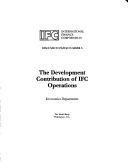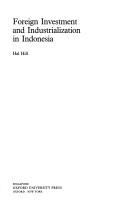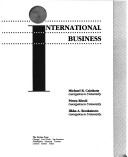| Listing 1 - 10 of 59 | << page >> |
Sort by
|
Book
Year: 1989 Publisher: Cambridge, Mass. National Bureau of Economic Research
Abstract | Keywords | Export | Availability | Bookmark
 Loading...
Loading...Choose an application
- Reference Manager
- EndNote
- RefWorks (Direct export to RefWorks)
The effects of taxes on direct investment capital outflows are investigated using a theoretical model which integrates the investment and financial decisions of the parent and subsidiary. The resulting marginal qs and costs of capital show that intrafirm investment allocation and tax neutrality results critically hinge on the marginal financing regime. By identifying a channel(s) through which a specific tax policy affects firm decisions, the model evaluates the combined effects of the home country tax system on direct investment. Out analysis suggests that while the 1986 U.S. Tax Reform Act may have an ambiguous effect on the overall level of capital outflows, it may induce more equipment investments to be undertaken abroad.
Investments, Foreign. --- Investments, Foreign --- Decision making.
Periodical
Abstract | Keywords | Export | Availability | Bookmark
 Loading...
Loading...Choose an application
- Reference Manager
- EndNote
- RefWorks (Direct export to RefWorks)

ISBN: 0821312758 Year: 1989 Publisher: Washington The World Bank /International Finance Corporation
Abstract | Keywords | Export | Availability | Bookmark
 Loading...
Loading...Choose an application
- Reference Manager
- EndNote
- RefWorks (Direct export to RefWorks)
Periodical
Abstract | Keywords | Export | Availability | Bookmark
 Loading...
Loading...Choose an application
- Reference Manager
- EndNote
- RefWorks (Direct export to RefWorks)
International finance --- Investments, Foreign --- International finance. --- Investments, Foreign.
Book
ISBN: 2883250006 9782883250000 Year: 1989 Publisher: Le Mont-sur-Lausanne: Meta,
Abstract | Keywords | Export | Availability | Bookmark
 Loading...
Loading...Choose an application
- Reference Manager
- EndNote
- RefWorks (Direct export to RefWorks)
Conflict of laws --- Investments, Foreign (International law)
Book
Year: 1989 Publisher: Cambridge, Mass. National Bureau of Economic Research
Abstract | Keywords | Export | Availability | Bookmark
 Loading...
Loading...Choose an application
- Reference Manager
- EndNote
- RefWorks (Direct export to RefWorks)
In a one-period model where each investor consumes a single good, and where borrowing and lending are private and real, there is a universal constant that tells how much each investor hedges his foreign investments. The constant depends only on average risk tolerance across investors. The same constant applies to every real foreign investment held by every investor. Foreign investors are those with different consumption goods, not necessarily those who live in different countries. In equilibrium, the price of the world market portfolio will adjust so that the constant will be related to an average of world market risk premia, an average of world market volatilities, and an average of exchange rate volatilities, where we take the averages over all investors. The constant will not be related to exchange rate means or covariances. In the limiting case when exchange risk approaches zero, the constant will be equal to one minus the ratio of the variance of the world market return to its mean. Jensen's inequality, or "Siegel's paradox," makes investors want significant amounts of exchange rate risk in their portfolios. It also makes investors prefer a world with more exchange rate risk to a similar world with less exchange rate risk.
Foreign exchange --- Investments, Foreign --- Mathematical models.

ISBN: 0195888847 Year: 1989 Publisher: Singapore : Oxford university press,
Abstract | Keywords | Export | Availability | Bookmark
 Loading...
Loading...Choose an application
- Reference Manager
- EndNote
- RefWorks (Direct export to RefWorks)
Industrial economics --- International finance --- Indonesia --- Industrialization --- Investments, Foreign --- History
Book
Year: 1989 Publisher: Basle: Bank for international settlements,
Abstract | Keywords | Export | Availability | Bookmark
 Loading...
Loading...Choose an application
- Reference Manager
- EndNote
- RefWorks (Direct export to RefWorks)
Balance of payments --- Investments, American. --- Investments, Foreign --- United States

ISBN: 0030145333 9780030145339 Year: 1989 Publisher: Chicago (Ill.): Dryden press,
Abstract | Keywords | Export | Availability | Bookmark
 Loading...
Loading...Choose an application
- Reference Manager
- EndNote
- RefWorks (Direct export to RefWorks)
International finance --- Investments, Foreign --- International business enterprises --- International trade
Book
ISBN: 3800510227 Year: 1989 Publisher: Heidelberg : Recht und Wirtschaft,
Abstract | Keywords | Export | Availability | Bookmark
 Loading...
Loading...Choose an application
- Reference Manager
- EndNote
- RefWorks (Direct export to RefWorks)
Investment guaranty insurance. --- Investments, Foreign --- Law and legislation
| Listing 1 - 10 of 59 | << page >> |
Sort by
|

 Search
Search Feedback
Feedback About UniCat
About UniCat  Help
Help News
News